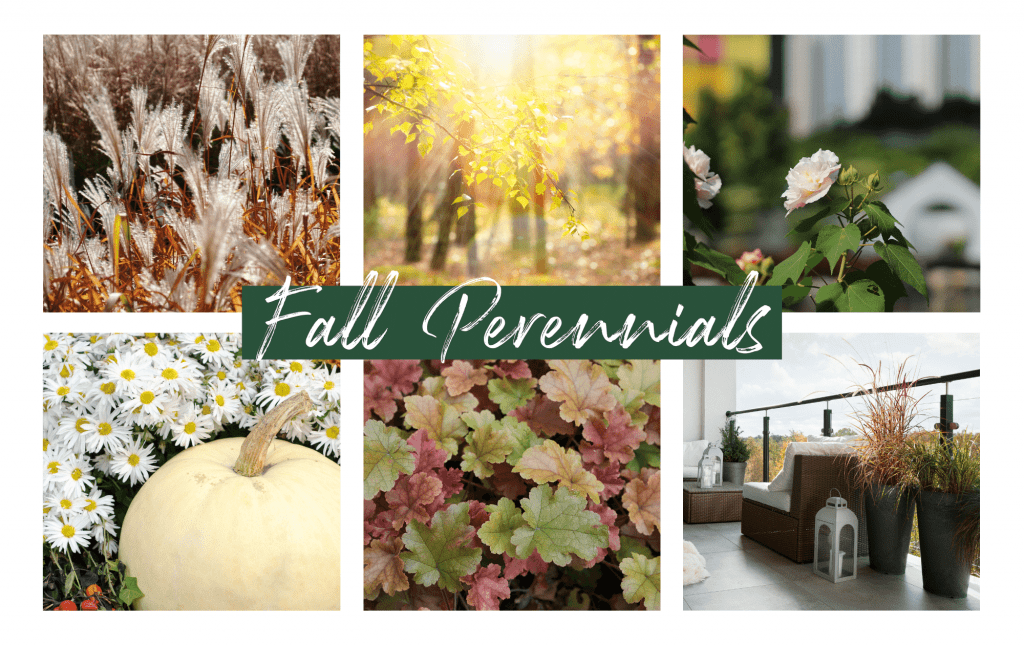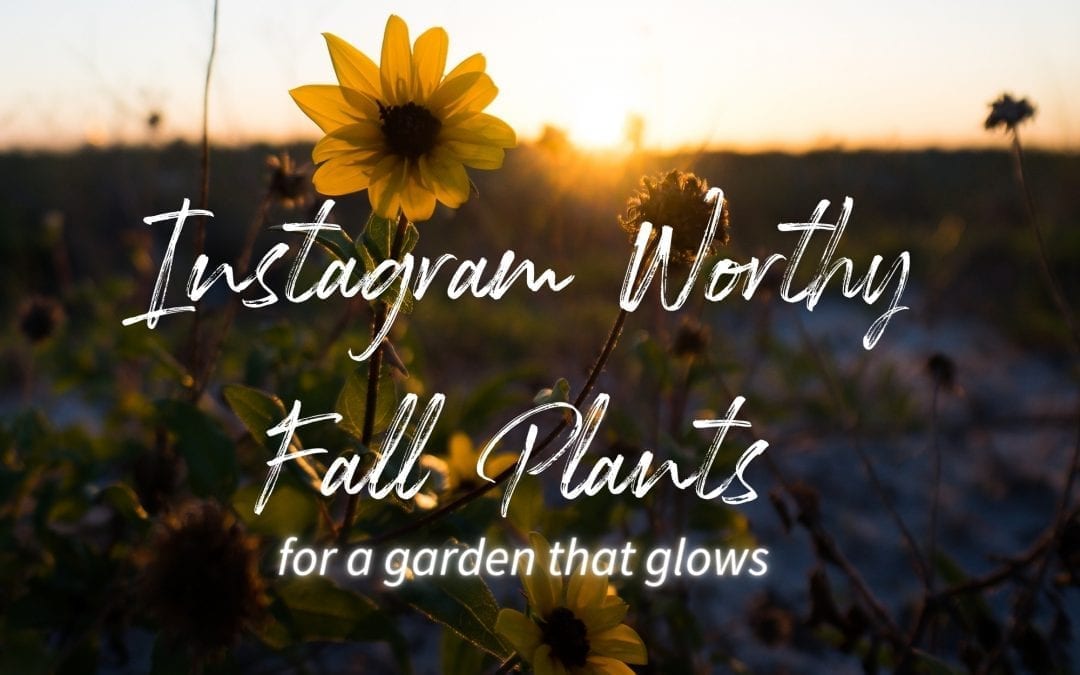Fall plants offer a unique ability to increase the seasonal aesthetic and overall atmosphere of our gardens. At this time of year, the temperatures are starting to cool down and it can be much more comfortable to get outside. Autumn projects like changing up our planters or adding fall interest to flowerbeds allow us to delight in the beauty of the season. We’ll provide some suggestions for annuals and perennials that are in their prime right now.
Fall is also about getting cozy. It’s a time to enjoy the “hygge” of outdoor fires, roasting marshmallows, and snuggling up with our loved ones.

Wouldn’t it be nice to have a beautiful view to enjoy during the evening golden hour? We’ll provide a few pointers on how to create a great vignette or garden vista.
The Best Fall Plants: Annuals
Annuals are plant varieties that need to be planted every year. They can refresh tired plantings from a prior season, or they can be a joyful celebration of the new months ahead when grouped pleasingly in a pot. Tim Pollak from Chicago Botanic Garden weighed-in:
“Start replacing bloomed-out annuals and container plants with fresh color, such as chrysanthemums, asters, ornamental grasses, kale and cabbage, fall pansies and violas, heuchera, and other plant offerings that Platt Hill Nursery has available in the fall for late season change-outs.”

Here’s what’s fresh at the garden center this season:
Annual Grasses
Great in both the landscape and containers, annual grasses pack a punch. They add lots of height and help balance the proportions of other fall plantings. Millet is a grass that provides both structure and food for birds and wildlife. Ornamental grasses like purple fountain grass or a caramel colored sedge grass look particularly nice when paired with classic fall annuals.
Asters
Many may mistake these flowers for daisies, but asters don’t begin to bloom until late summer. And they’ll continue to bloom through October! Some varieties may be perennials, but asters are a great addition to planters and container gardens. Because of this, some gardeners may treat asters like an annual.
Marigolds
It’s hard to pass up purchasing marigolds in the fall. They’re available in a mixture of classic fall colors like yellow, orange, gold, red, and white. Some may know marigolds from their ability to ward off vegetable garden pests due to their smell. But, not all varieties have a strong odor.
Mums
Few sights are more nostalgic than seeing some happy little mums springing up to greet autumn. These plants work well in pots, planters, and the landscape. They’re available in several cheerful autumn colors. Once purchased and planted, they require little care, other than watering and cutting off spent blooms. (This process is called deadheading).
Pansies
Pansies are some of the most frost-resistant annual flowers if they’re planted early enough in September to get established and let roots develop. Though they can’t tolerate our summer heat, they love the cool weather fall provides.
Petunias
These workhorses of the garden may have been around all season, but you can once more find them at the garden center. Available in a variety of colors, these plants will bloom their heads off in properly draining soil. Allow the soil to dry out between waterings. And, feed them once a week with an all-purpose fertilizer to keep them going until frost.
Ornamental Peppers
While these sassy little plants are not in the edible category, they warm up a pot or planter beautifully and complement other fall-colored plantings.
PRO TIP: To keep your annual’s color popping through October, make sure to deadhead spent blooms. This applies to your asters, mums, marigolds, pansies, and petunias. Otherwise, they require little maintenance than regular watering and feeding.
Top Fall Perennials
Perennials are plants that will regrow after a period of dormancy, and one major appeal of perennials is their ability to reduce the amount of new planting you have to do each year. Laura from Platt Hill Nursery recalls her mother sharing with her, “Perennials are permanent, when planted properly.” This alliteration is a helpful reminder to gardeners, new and experienced.
We’ve included a bit more about the traditional perennials for fall, but there are many more to explore aside from these.

Heucheras
Discover the saturated foliage of heucheras, which can add a beautiful pop of color with little effort. They prefer a more shaded spot in the garden, but certain varieties can manage well in dappled or part sun.
Hibiscus
Any variety of hibiscus is phenomenal, with its late-summer through fall giant blooms and beautiful leaves. Our very own vice president of Platt Hill Nursery, Clark Hill, recommends checking-out Starry Starry Night for its beauty.
Montauk Daisy
These daisies prefer warm, but not excessively hot conditions, which makes them a great fall flower. It’s a tough plant that’s resistant to both salt and drought; in fact, it’s main nemesis is planting medium or soil that doesn’t drain properly. Montauk daisy blooms in fall and makes a great late-season cut flower.
Ornamental Grasses
Dive into the world of ornamental grasses and you’ll find around 10,000 species in total. Limit that a bit further to hardy varieties that will return next year after a Chicago winter, and there are still grasses of all shapes, sizes, and colors. Some offer beautiful autumn colors, and most ornamental grasses really hit their stride in August and September, when soil temperatures are warmest.
PRO TIP: Don’t be afraid to use perennials in your planters. You can either treat them as an annual or be sure to get them planted in-ground my mid-October. Planting in-ground in October helps the plants get established before winter sets in. This applies to heucheras, rudbeckias, Montauk daisies, and asters.
Crafting Glowing Garden Vistas for Fall Instas
Creating a vista in your garden is all about creating a pleasing view. Fall plants offer some great options to spruce up your view as you relax in front of the fire pit or have coffee on your balcony. In an extra small space, rather than creating a vista, you might be more interested in creating a cozy vignette. A ‘staging vignette’ originated as a real estate term, but this concept all about creating small scenes to make it more inviting and enjoyable.

Aesthetic preferences are ultimately up to you, as the gardener. If your intention is to develop your garden vista as living art, then understanding basic design concepts can help you achieve your vision.
Get A Garden Focal Point
Your focal point will most likely depend on where you want to view that part of your garden. For some, especially smaller gardens or balcony gardeners, the view will most likely be at the entry point. But, it’s also possible to set your view from your seating area, fire pit, or garden niche. Then, figure out what you’ll want to draw your eye most. That element is your focal point.
Add A Little Mystery To Your Vista
Partially-visible elements add a sense of mystery to a garden scene. You may have experienced this phenomenon before when looking down a winding path, or finding an opening in a hedge or tree line that draws your eye to the area beyond. For example, the gazebo image in the above collage is drawing your eye to the structure, partly because of its size and partly because it’s partially obscured by the rosebush. This technique can also add a sense of movement.
PRO TIP: Consider choosing either a focal point or mystery for small spaces. On a balcony, possible focal points might include a larger, striking fall plant, a small statue, a vintage birdcage, or maybe even an antique lantern. These unique finds may be waiting for you in-store on your next visit to Platt Hill Nursery.
Get Your Garden Lighting Right
In photography, lighting is everything. So, if you’re going for instagram, you may want to wait for “golden hour” where light isn’t as harsh as it might be in the middle part of the day. Getting great lighting for your garden vista is just as important as it is for creating a styled vignette. “Golden hour” is typically around sunrise or sunset, where lighting can be redder and your subjects (your garden or plants) won’t be as washed-out. Knowing where the sun will rise and set on the horizon allows for strategic planning of trees or shrubs to perfectly filter light in fall.
But, solar lighting or electrically powered landscape lighting can also add drama to your evenings. Use lights at ground-level to highlight and up-light a featured tree. Or, add downward-pointed pathway lighting to highlight an easy path from one part of your garden to the other.
Platt Hill Nursery is Chicago’s premier garden center and nursery.

